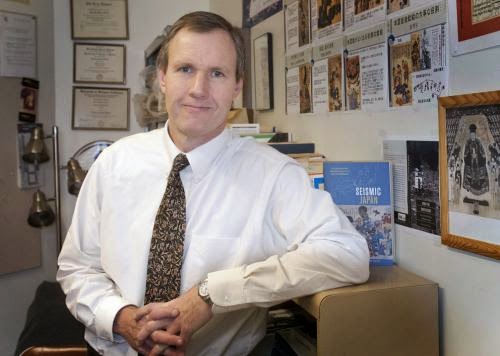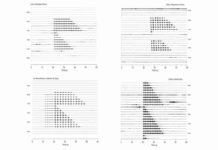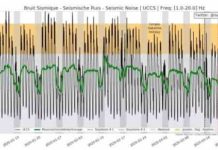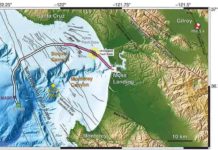
Greg Smits’ interest in earthquakes began with a catfish. A book full of catfish, to be precise.Back in 2002, Smits, then an assistant professor of history at Penn State, was poking around a used book store in Tokyo, looking for titles relating to his specialty, the intellectual history of Japan, when a large and colorful volume caught his eye.
It was a comprehensive, illustrated treatment of namazu-e, the brash, fantastic, often satirical prints depicting namazu—mythical giant catfish—that proliferated in the aftermath of the great Ansei Edo earthquake of 1855. Its price had been marked down drastically, and the bargain was too good to resist.
“I bought the book and took it home, and it sat on a shelf for years,” Smits recalls. “I finally got around to reading it, and thought as long as I’ve plowed through this I should write something about it.”
At the time, Smits had posted on his professional web page a series of self-written textbooks for use by students in his classes on Japanese history. By the miracle of Google, the chapter he posted on namazu-e found its way to Ruth Ludwin, a University of Washington seismologist who was researching the native earthquake lore of the Pacific Northwest.
“Ruth contacted me with a bunch of questions,” Smits remembers. “We eventually wrote an article together, and by the time it was finished I was hooked. I’ve been working on the history of Japanese earthquakes ever since.”
That work has now culminated in two books released in rapid succession, the first a close look at the pivotal Ansei Edo earthquake and its enduring legacy, and the second tracing the broader history of Japanese earthquakes since the 17th century. Both volumes provide important context for the massive disaster that struck the country in March 2011, and whose impacts are still unfolding.
An Earth-shaking Event
According to this thinking, Edo was safe from earthquakes, since the city’s plentiful water wells provided a means of relieving underground pressure. “So when this earthquake struck, one of the things it shook up was scientific thought,” Smits says.
The disaster also exacerbated discontent between different groups in society, especially with respect to disparities in wealth. That’s where the pictures of catfish come in. Catfish, Smits explains, had long been regarded as a symbol for earthquakes. “There’s this whole elaborate mythology, where catfish symbolize the unruly forces under the earth.”
In November of 1855, they became something else. “Two days after the initial earthquake, hastily printed, anonymous broadsheets and images began to appear for sale around the city,” Smits wrote in the Journal of Social History. Over 400 varieties of these namazu-e were soon spilling out everywhere, most of them featuring giant, anthropomorphized catfish.
Some of these prints show angry citizens attacking the local deities who allowed namazu to run rampant. In others, remorseful catfish apologize for their destructive behavior. In still others, gods shower coins on happy tradesmen who would profit from rebuilding, embodying a popular idea that the earthquake had set the world to rights by correcting an imbalance of wealth.
“Namazu-e were a coded mechanism for making statements about politics or society,” Smits says. “Among other things, they tended to show the bakufu, this powerful military government, as helpless vis-a-vis the forces of nature. The invincibility of this military organization was suddenly brought into question.”
Sensing the potential import of the catfish prints, the bakufu moved within a month to suppress them. By 1867, the bakufu government would fall, and a new government would form around the emperor. “The earthquake didn’t cause this collapse,” Smits says, “but it set the stage and presaged it in the realm of rhetoric.”
Ongoing Aftershocks
Another supposed signal of impending doom was unusual activity observed in—you guessed it—catfish. Instead of their usual bottom-dwelling torpor, these fish, pre-earthquake, would be seen swimming on the surface of the water. Cue disaster.
In fact, Smits notes, the idea that catfish can predict earthquakes still survives in Japan. Government-funded experiments observing catfish in aquariums continued as recently as 1993, and newspaper speculation on the connection between fish and earthquakes popped up repeatedly after the March 2011 disaster.
The broader belief that seismic events can be reliably predicted is a topic Smits takes up in his second book. “In every earthquake since 1855, you get these long lists of possible precursors, all of them applied after the fact,” he says. “It’s almost like there’s a religious faith in this idea.”
Today, “Japan spends more money on earthquake prediction than any other developed country, and probably all the rest combined,” Smits adds. “This has produced zero predictive results.”
In addition to being a blind alley, the relentless focus on prediction, he suggests, may feed a troubling gap between what scientists actually know and the public perception of what they know, a gulf that was on dramatic display in the recent much-publicized case of seismologists sentenced to jail for failing to adequately warn people about the 2009 earthquake in L’Aquila, Italy.
“In the ’60s, in Japan, you had this public perception that surely we should be able to predict earthquakes by now,” he says. “This put great pressure on the seismological community to claim that earthquake prediction was possible.” But when the Kobe earthquake hit in 1995, killing 7,500 people, “it was absolutely unpredicted,” Smits says. “They didn’t even know that the fault that caused it existed.
There was a lot of scrambling among earthquake research agencies, and now, instead of ‘predicting,’ they talk about ‘forecasting.’ But the forecasts are so broad as to be of little practical use.”
Lessons from History?
Smits also criticizes the notion of “characteristic earthquakes” that pegged the 2011 disaster as a 1,000-year event, “as though the rupture of faults occurs at regular intervals, and now that this one has happened we can relax for another thousand years.”
That kind of rhetoric, he argues, only aggravates general misperceptions. “Instead, wouldn’t it be good if the government and the scientific community spoke in a unified voice, and said loud and clear, ‘We can’t predict earthquakes’? ‘And ‘There is no place on these islands that is not subject to the possibility of a serious earthquake, but here’s how you can minimize the danger’? I think that would help.”
It would at least reflect the lessons learned from the record of earthquakes past.










